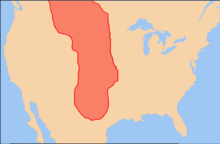Plano cultures
 Map of the Great Plains region | |
| Geographical range | Great Plains |
|---|---|
| Period | Archaic |
| Dates | 9000 – 6000 BCE |
| Preceded by | Paleo-Indians |
| Followed by | Old Copper Complex |
ThePlano culturesis a name given byarchaeologiststo a group of disparatehunter-gatherercommunities that occupied theGreat Plainsarea ofNorth Americaduring thePaleo-IndianorArchaic period.
Distinguishing characteristics
[edit]The Plano cultures are characterised by a range of unflutedprojectile pointtools collectively calledPlano pointsand like theFolsom peoplegenerally huntedBison antiquus,but made even greater use of techniques to force stampedes off of a cliff or into a constructed corral. Their diets also includedpronghorn,elk,deer,raccoon,andcoyote.To better manage their food supply, they preserved meat in berries and animal fat and stored it in containers made of hides.[1][2][3]
History
[edit]The Plano cultures existed in the North American Arctic during thePaleo-IndianorArchaic periodbetween9000 BCEand6000 BCE.The Plano cultures originated in the plains, but extended far beyond, from the Atlantic coast to modern-day British Columbia and as far north as the Northwest Territories.[4][5]"Early Plano culture occurs south of theNorth Saskatchewan Riverin Saskatchewan and in the foothills of the Rocky Mountains north to thePeace RiverValley of Alberta and adjacent British Columbia. At this time, most of Manitoba was still covered byGlacial Lake Agassizand associated glacial ice. "[4]
Bison herds were attracted to the grasslands and parklands in the western region. Around 9,000 B.P. as retreating glaciers created newly released lake regions, the expansion of plant and animal communities expanded north and east, and thebarren ground caribouin the tundra,boreal woodland caribouin the boreal forests and plains, and mountain caribou replacedbisonas the major prey animal.[4]
In the Great Plains, the following are Plano cultures from 10,000 to 7,000 years ago, distinguished by long,lanceolateprojectile points:[6]
- Agate Basin complex, named for theAgate Basin Site.[7]
- Cody complex,named for the Horner site nearCody, Wyoming,includes theOlsen-Chubbuck Bison Kill Siteand theJurgens Site.[8]
- Hell Gap complex,such as theHell Gap,Wyoming site for which it was named and theJones-Miller Bison Kill Site.[6]
- Foothills / Mountain complex[8]
Citations
[edit]- ^"Evolution of Projectile Points".U.S. Department of the Interior, Bureau of Land Management. Archived fromthe originalon 2012-09-27.Retrieved2011-09-19.
- ^"Western Plano".Manitoba Archaeological Society.Retrieved2011-09-19.
- ^Waldman, Carl (2009) [1985].Atlas of the North American.New York: Facts on File. p.5.ISBN978-0-8160-6858-6.
- ^abcCanadian Museum of Civilization 2010.
- ^Reynolds et al.
- ^abCassells 1997,p. 79.
- ^Cassells 1997,p. 81.
- ^abCassells 1997,pp. 81–86.
References
[edit]- A History of Native People of Canada: Plano Culture,Canadian Museum of Civilization, 2010,retrieved2011-09-19
- Cassells, E. Steve (1997).The Archaeology of Colorado(Revised ed.). Boulder, Colorado: Johnson Books.ISBN1-55566-193-9.
- Reynolds, Graham; MacKinnon, Richard; MacDonald, Ken (1998–2002),Palaeo-Indian archaeology: The Peopling of Atlantic Canada,Nova Scotia, Canada: Canadian Studies Program, Canadian Heritage, Cape Breton University With Folkus Atlantic Productions in Sydney. Supported by the Canadian Studies Program, Canadian Heritage, archived fromthe originalon 13 July 2011,retrieved19 December2013
- Archaeological cultures of North America
- Archaic period in North America
- Indigenous culture of the Great Plains
- Native American history of Colorado
- Paleo-Indian period
- Pre-Columbian cultures
- Prehistoric cultures in Colorado
- Archaeology of the United States
- 7th millennium BC
- 8th millennium BC
- 9th-millennium BC establishments
